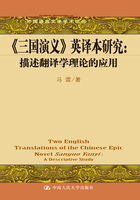
1.6 Theoretical framework
The following theoretical approaches to translation and translation strategies will be explained, considered and applied in the comparative study of the two translations.
1.6.1 Retranslation hypothesis
Retranslation is a common phenomenon in the history of translation. Since Roberts's translation is a retranslation, a discussion of this phenomenon is directly relevant to the current study. Although retranslation of scientific and technical texts is a best-avoided practice, the retranslation of literary texts has usually been regarded by many scholars as a positive phenomenon, since it contributes to the diversity of the available interpretations of and broadens perspectives on the ST (Gürçağlar 2009). The denotation of the concept of retranslation and the theoretical assumptions on this concept will be discussed in Chapter 3.
1.6.2 Linguistic approach versus functionalist approach
The linguistic approach to translation, which was put forward in the 1960s and developed by Nida, Newmark, Catford and Wills, operates mainly on a linguistic perspective of translation. This approach concentrates on the language systems of the two languages involved and claims that the ST is the yardstick against which the TT should be judged. The ideal translation would be a complete equivalent of the ST on all linguistic levels.
The functionalist approach, on the other hand, established by Vermeer, Reiss and Nord in the 1980s, was developed mainly in criticism of the linguistic approach. “Skopos” (a Greek word meaning “function” or“aim”) is the key concept in this approach. Some of the main ideas of the functionalist approach include the notions that a translation is regarded as translation when it functions as a text in the target culture; that the function of a translation in the target culture determines which aspects of the ST should be transferred to the TT; that the ST is only seen as a source of information; and that the success of a translation is determined by whether it is interpreted by the target reader in a way that is coherent with his or her situation. The concept of equivalence is also used in the functionalist approach (cf. Nord 1997: 89-91), but in a different sense than in the linguistic approach.
with his or her situation. The concept of equivalence is also used in the functionalist approach (cf. Nord 1997: 89-91), but in a different sense than in the linguistic approach.
1.6.3 Domestication versus foreignization
The frequently-quoted words of Schleiermacher explain the difference between domesticating and foreignizing strategies in translation: “There are only two (methods of translating). Either the translator leaves the author in peace, as much as possible, and moves the reader toward him (foreignization). Or, he leaves the reader in peace, as much as possible, and moves the author toward him (domestication)” (Schleiermacher, as quoted in Lefevere 1992: 149).
Different translators may employ different strategies in their translations. For instance, to be loyal to the author of the ST, some native Chinese translators are inclined to use foreignizing strategies to translate from Chinese into English, while native English translators might use domesticating strategies to translate Chinese texts in order to make their translations more accessible to English readers. It may also happen that the same translator uses both strategies during a translation. The two translations that are examined in this study were both produced by native English speakers. A careful investigation will be conducted to analyze the strategies used by both translators during the translation process.
1.6.4 Descriptive studies of the two translations
From the 1980s onwards, the focus in and of Translation Studies (TS) has been shifting from text to context. Accordingly, an increasing amount of research in TS has been dedicated to the relationships between translations and the cultures that generate them. In keeping with this development in the field, a descriptive study will be conducted on the two English translations of Sanguo Yanyi. Descriptive Translation Studies (DTS) describe translations as facts of target systems. This approach focuses on pragmatic aspects, such as social, cultural and communicative practices instead of on linguistic units. Translation is namely seen as the result of a socially contextualized activity (Toury 1985). Within this framework, decision-making processes and translation strategies and norms employed and adhered to by the two translators of Sanguo Yanyi will be investigated and examined. Moreover, a description of the entire translation process, from the translators' original planning to the agents acting as patrons of the project to the reception and influence of the TTs in the English-speaking world will be discussed.